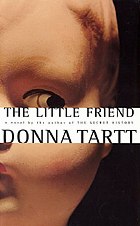
The Little Friend, by Donna Tartt, read by Karen White, Books on Tape, Inc., 2002
There is something fascinating to me in authors who either take long sabbaticals in between books or for whom the writing process is a slow one, fraught with blocks and deliberate carving out of words. It took Mark Twain something like seven years to complete a novel, and he was always setting it aside to work on another piece and coming back to it when inspiration struck. James Joyce’s novels are a study in slow crafting.
Fourteen years ago, Donna Tartt debuted with a thick psychological thriller that was also part satire on college literary types, philosophy, classicism, and the student professor relationship. That book, The Secret History, was a high-brow debut that didn’t mind dishing in some low-brow elements the way best literature does — and it showed that there really are some talented American writers willing to plow the thriller genre for deeper insights than how a bullet pierces a skull.
In 2002, after ten years' wait, Tartt published The Little Friend, another sizable tome in the psychological thriller canon, and like its predecessor, intelligent, knowing, multi-layered, multi-faceted, and without any easy answers for the reader. The book’s barest outlines and even some of its characters mirror quite resoundingly Harper Lee’s To Kill a Mockingbird, in which we have Harriet, a tomboyish girl growing up in small southern town in the early 70s, followed around by her younger friend, a boy named Hely, and the unfolding of the town mystery.
Only, the mystery in question is about the death of Robin Cleve Dufresnes, Harriet’s nine year old brother who was found hanged when Harriet was only an infant. The murderer, and almost everyone in town believes it was murder despite an inconclusive autopsy, was never caught. Twelve years later, like many adolescents, Harriet is obsessed with secrets, reading books about Atlantis, Mu, and other mysteries of time, poking her nose into her aunts’ business, and generally snooping around town. The mystery of her brother’s death is simply too close to ignore. Through a series of coincidences happening around her town, Harriet begins to believe she knows who the murderer is.
Alongside this engaging portrait of a sensitive, intelligent young girl (who sometimes is a monumental pain in the ass), Tartt dishes out a degenerate family of meth dealers and petty criminals who do things for fun like take potshots at poor black fishers alongside the riverbank. Danny Ratliff, part-time runner for his older, psychotic brother Farish, is Harriet’s prime suspect. As the novel unfolds on one track, Harriet and Hely plotting revenge, on the other we meet each member of the Ratliff’s including their grandmother who discourages even the slightest dreams in her relatives though not from any malicious intent. Each member of this more-dysfunctional-than-the-Lesters-of-Tobacco-Road lives in his or her own trailer, Farish and Danny growing ever more hostile to each other as their meth addictions unwind their brains. Paranoia, drugs, money, guns, and an excess of testosterone is never a good mix, and Tartt, who knows her Plato and her Aristophanes with the best fiction writers, here sketches consciousnesses undone by their own excesses with a sharp eye.
While there is some great poetry in the scenes of the Ratliff family interacting, Tartt’s especially fine with the child psychology. For example, when planning how to revenge themselves on Danny Ratliff, Harriet, a Sherlock Holmes fan, cribs from “The Speckled Band” and plans to drop a venomous snake on him. Then there are amusing little details like how Hely, when the two break into a an apartment to steal a snake from a Pentacostal minister’s collection, pees on the floor because he had a strange notion that if anyone kidnapped him, they wouldn’t let him use the bathroom but would make him soil himself as part of their torture.
It’s the strange logic of childhood that Tartt hits neatly whether for a boy or a girl (though to be fair Harriett’s tomboyish logic is more stereotypically male with her love of Houdini and Dark Shadows and is disarmingly refreshing for that). The kind of hazy fixated obsessions that kids have are represented delightfully here, the way kids can reread a book they’ve read a hundred times before and enter into a near comatose state of rapture; the idea of splashing snakes with gasoline and burning a whole ball of them is to them both repulsive and fascinating; wandering around in the woods all by yourself daydreaming is completely normal.
One of the best elements of this coming of age aspect of the story is how there are moments when actions and their aftermath break the day into distinct pieces, how you can have three days in one, goofing off before you dump a cobra off a bridge into a Trans-Am sunroof, dumping said snake, and how after you dumped the snake you still had to eat beets for dinner. All three of these elements exist in near isolation in the child mind, and Tartt remembers this clearly and delivers it to the reader just so.
Reader Karen White handles a variety of accents and female voices with assuredness. Whether she’s delivering Harriet and Hely’s youthful snottiness; Harriet’s maid and stand-in mother Ida Rhew, the family’s black maid; any one of four aunties batty as all get out; or the depraved snorts of the Ratliff’s, including their retarded youngest brother, Curtis, White leaves you with no doubt who is speaking. This is one of the finer arts of audiobook narration and White scores a near perfect for her efforts.
No comments:
Post a Comment